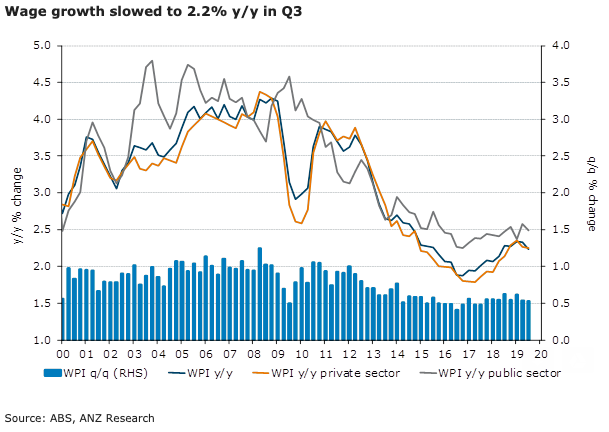Australia’s wage price index (WPI) rose by 0.5% q/q in Q3 2019, slowing annual growth to 2.2%. With the Q2 result inflated by a significant, one-off increase in Victorian public sector health wages, the Q3 result is seen to be more reflective of the rise in labour market underutilisation since early 2019, along with the deterioration in enterprise bargaining agreement (EBA) wage increases since late 2018.
The slowdown in wage growth is not unexpected, but it will put further pressure on household incomes.
The private sector maintained quarterly growth at 0.5 percent, but this wasn’t enough to prevent annual growth slipping to 2.2 percent, down from 2.4 percent in Q1. However, including bonuses, private sector wage growth jumped to 2.9 percent y/y. This effectively reversed the prior quarter’s fall, and we don’t think it points to an upward shift in wage outcomes.
Public sector wage growth dropped back to 0.5 percent q/q. This followed a very strong 0.8 percent q/q result in Q2, which was inflated by a significant, one-off increase for Victorian public sector nurses and midwives to achieve parity with New South Wales. Annual growth in public wages slowed to 2.5 percent.
Most industries saw annual wage growth slow in Q3, with the largest decline in other services (-0.4ppt). Transport (+0.2ppt) and professional services (+0.1ppt) were among the few that saw improvement. Annual wage growth in construction and retail was unchanged during the quarter.
Victoria maintains the strongest wage growth in the country at 2.8 percent y/y, followed by the ACT (2.5 percent y/y). While some economic indicators have been showing recent positive signs for Western Australia, this doesn’t appear to be flowing through to wages yet, with growth still at 1.6 percent y/y.



 Singapore Growth Outlook Brightens for 2025 as Economists Flag AI and Geopolitical Risks
Singapore Growth Outlook Brightens for 2025 as Economists Flag AI and Geopolitical Risks  FxWirePro: Daily Commodity Tracker - 21st March, 2022
FxWirePro: Daily Commodity Tracker - 21st March, 2022  Dollar Holds Firm Ahead of Global Central Bank Decisions as Yen, Sterling and Euro React
Dollar Holds Firm Ahead of Global Central Bank Decisions as Yen, Sterling and Euro React  Gold Prices Fall Amid Rate Jitters; Copper Steady as China Stimulus Eyed
Gold Prices Fall Amid Rate Jitters; Copper Steady as China Stimulus Eyed  Asian Stocks Slide as AI Spending Fears and Global Central Bank Decisions Weigh on Markets
Asian Stocks Slide as AI Spending Fears and Global Central Bank Decisions Weigh on Markets  U.S. Stock Futures Slip After CPI-Fueled Rally as Markets Weigh Economic Uncertainty
U.S. Stock Futures Slip After CPI-Fueled Rally as Markets Weigh Economic Uncertainty  U.S. Dollar Steadies Near October Lows as Rate Cut Expectations Keep Markets on Edge
U.S. Dollar Steadies Near October Lows as Rate Cut Expectations Keep Markets on Edge  Asian Currencies Slip as Dollar Strengthens; Indian Rupee Rebounds on Intervention Hopes
Asian Currencies Slip as Dollar Strengthens; Indian Rupee Rebounds on Intervention Hopes  Austan Goolsbee Signals Potential for More Fed Rate Cuts as Inflation Shows Improvement
Austan Goolsbee Signals Potential for More Fed Rate Cuts as Inflation Shows Improvement  Asian Currencies Trade Sideways as Dollar Weakens Ahead of Key U.S. Data
Asian Currencies Trade Sideways as Dollar Weakens Ahead of Key U.S. Data  U.S. Stock Futures Edge Higher as Micron Earnings Boost AI Sentiment Ahead of CPI Data
U.S. Stock Futures Edge Higher as Micron Earnings Boost AI Sentiment Ahead of CPI Data 































